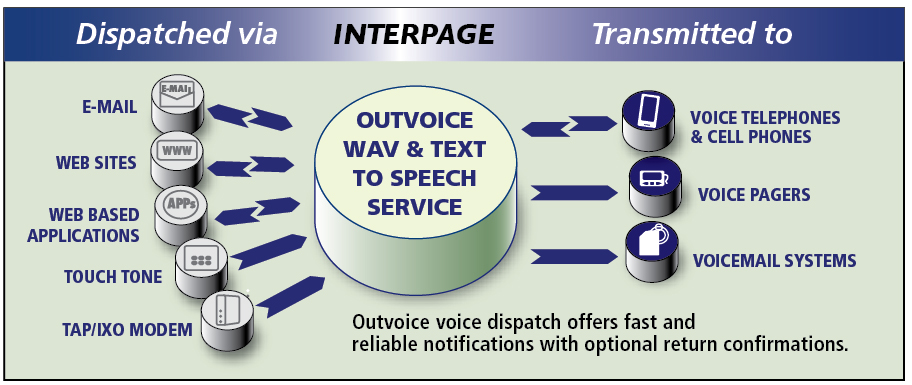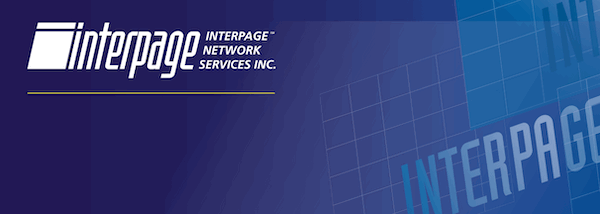The OutVoice service is easily integrated into your current messaging platform using various methodologies to connect to Interpage's servers, such as e-mail, web submission HTTP/HTTPS, and other TCP/IP or telephonic means. OutVoice alert messages are immediately sent to (voice) end-devices, such as telephones, cellphones, or may be deposited directly to voicemail via a voicemail system's "back door" access number.
Outvoice, in conjunction with the Messaging/Paging Gateway and Outfax(sm) services, allows for complete connectivity and dispatching via a single, common interface and protocol to nearly any telephonic, mobile, or messaging device utilizing Interpage's messaging, notification, and alert services.
[ Back to Main
| Flat Version
| Voice Svcs Main
| Features
| OutVoice Spec Sheet
| Costs
| FAQ
| OutVoice Demo
| Signup Form
| Contacts ]

Messaging customers who require a means to immediately send verbal notification to one or more telephones and/or cellphones by synthesized/text-to-speech (TTS) or pre-recorded, customer-generated messages (via WAV files) may utilize OutVoice (as a standalone service or in conjunction with Interpage's other messaging/dispatch options) for critical/emergency alerts or time-sensitive information to ensure that the given alert or message is heard immediately by the intended recipients.
The OutVoice Dispatch Service was designed so that when critical or time-sensitive information needs to be relayed to a desired recipient(s), the entire spectrum of available telecommunications devices - from cellphones, pagers, mobile laptops, smartphones, and even traditional 'POTS'/landline phones - is available to broaden an enterprise's or business' ability to reliably contact them, even when wireless and internet facilities are lacking.
Customers may "fill out" their dispatch or notification regime by calling, via voice channels, POTS (Plain Old Telephone Service) or cellular lines as a more immediate means to alert or inform primary responders, or, for example, as part of an alert escallation regime when emergency/primary responders are unavailble. Thus, if an "on call" pager or cellphone is unreachable, rather than invest in multiple on call "backup" pagers, the OutVoice serivice may be used to automatically notify alternate contact individuals via a more immediate voice notification message, thus saving the equipment and monthly cost of addidtional on-call pagers, 2-Way/Blackberry type devices, or other subscription messaging methodologies.
OutVoice may also be scripted so that messages may be deposited after-hours on various voicemail platforms, including "generic" or "port access" numbers which can be dialed without ringing a given extension so as to "silently" deposit an alert or other informational voicemail.
OutVoice requires no additional equipment, software, or special programming; messages are dispatched and can be dynamically configurable via simple e-mail commands which are easily integrated into a notification platform and/or redundancy/failover servers by sending mail directly to Interpage's servers for immediate message dissemination.
Status messages can optionally be sent back for each OutVoice message to inform the sender/server as to its status and ultimate receipt by the destination/recipient. Using a protocol similar to the Text Messaging and Alpha/Numeric Paging Gateway and OutFax(sm) services, OutVoice responds with a queue confirmation to report that a given text or WAV file has been accepted and is being sent out, followed by a success or fail confirmation reporting the disposition of the message and if it was successfully delivered or not.
Features
The OutVoice service offers the following features:
Supports both plain text and WAV files Fast Text-to-Speech engine and WAV conversion High-quality, male and female voices for speech synthesis Recipients may optionally be prompted to confirm receipt Robust, parsable, and redirectable confirmation messages back to originator End-user may accept, retry, or reject a message with prompting Scriptable dial-out routines for complex voicemail navigation Real-time, online status for OutVoice/003 accounts and higher Dynamically configurable options which may be invoked on a per-message basis No special equipment or programming/software development required Easily integrated by sending simple e-mail commands to the OutVoice server Know with certainty if an alert/message has been received by the desired party with recipient confrimations back to the sender A single Outvoice account may be accessed from multiple corporate or cloud-based servers OutVoice accepts e-mail messages, web submissions, Touch Tone, and TAP connections as triggers to initiate a voice call/alert Common protocol with SMS/text & paging and Fax notification and alert services
The following is a summary of e-mail command codes; a more detailed list with examples and syntax may be found at the OutVoice Commands page.
VOICE [options] phone recipient
Options:
-code [word] Mark message with code 'word' (any string w/o spaces)
-conf Generate a QUEUED confirmation
-noconf Do not generate a QUEUED confirmation (restricted)
-confsucc a@b.com Send a success confirmation to a@b.com
-conffail c@d.org Send a fail confirmation to c@d.org
-queuesucc e@f.com Send a successful queue confirmation to e@f.com
-queuefail g@h.net Send a failed queue confirmation g@h.net
The following additional voice-specific options apply to Outvoice only:
-ivr (and -noivr) : [default is -ivr]
Play interactive voice response messages
around your message to ensure successful
receipt. Recipient is prompted to press "1"
to accept, "2" to decline, or "3" to be called
back. "*" aborts and returns success after acceptance.
-noivr prevents the use of the IVR interface.
-wait (and -nowait) : [default is -wait]
Wait to hear a sound from the callee before
proceeding through the message playing. Callers will
typically say "Hello", which will prompt OutVoice to
commence transmission of the given message. -nowait
will prevent this initial wait. (Generally used with
the -pause command to hard code a fixed dial/ring
time.)
-pause [seconds] : [default is 9 seconds]
Time (in seconds) to pause before playing message.
(Applicable only when using -nowait option).
-voice [voice] : [options are 'female' (default) and 'male']
Use either a male or female voice during
text-to-speech (TTS) synthesis.
-maxplays [plays] : [default is 5 plays]
Maximum number of times the system will play the
message (in the event the recipient did not press
"1" or the system was unable to connect; also limits
the number of times the recipient may press "3" to
replay the message).
-wava : [defaults to ignore WAV attachments]
Similar to -doca in the OutFax(sm) Service,
denoting a WAV audio file attachment. No argument
is taken with -wava ; -wava tells Outvoice to expect
an attached WAV audio file in the body of the message.
Outvoice Plans and Pricing
The OutVoice Service is offered under the following rate plans:
Note: "US" refers to the 50 US States and Washington, DC. Rates outside of the US and Canada vary; please consult Interpage for details. All plans have a one-time set-up fee equivalent to their monthly rate basis.OutVoice/001: $10 per month, 10 cents per minute to the US/Canada. OutVoice/002: $50 per month, 5 cents per minute to the US/Canada OutVoice/003: $250 per month, unlimited "standby" messaging to the US/Canada OutVoice/004: $795 per month, unlimited dedicated messaging to the US/Canada OutVoice/006: Starting at $299 per month, enterprise-grade, multiply redundant, custom-branded OutVoice service, with notifications billed at 5 cents per minute to the US/Canada.
Frequently Asked Questions
OutVoice can be used to alert and notify anyone with a telephone - cellular, landline, satellite, or VoIP - of an important condition, emergency, or any other event. It also offers proof-of-reception as the called party/(ies) can be required to press "1" before the message is verbally relayed to them. When you need to be sure that your message has been received, OutVoice can provide certainty and proof that your message was delivered.
E-Mails and text messages can be delayed or unpredictable as to when they will be delivered, and in most cases provide no proof-of-receipt. Delivery to cellular phones and pagers can be further delayed and have less predictable delivery times when traveling in areas with poor RF coverage, or when coming out of a tunnel or subway. OutVoice relies on automated spoken voice messages, which are transmitted by a phone call to any telephone device, so in areas of less-than-optimal data coverage, or areas such as hospitals where cellphone use may not be allowed, messages can get through. OutVoice ends any ambiguity as to the delivery or receipt of a given message, as if an OutVoice notification call is answered, a confirmation is immediately sent back to you (and/or the originating notification server or system), ending any question as to its receipt by people who need to be reached.
OutVoice can be easily integrated with any server, web site, alerting system, online order fulfillment system, or other application which sends e-mail or text alerts. Your server simply sends an e-mail to the Interpage OutVoice system with the destination telephone number(s) which need to be notified, and OutVoice will read the text of the e-mail body, or replay a WAV file, to the destination telephone number(s). Callers can be required to acknowledge receipt, and confirmation thereof is mailed back to any e-mail address(es) which you specify. Rather than guess if a message was received by e-mail or text/SMS message, Outvoice provides certainty that a message was either received or was unable to be delivered in a short period of time. (Outvoice messages may also be dropped directly into outbound queues without the use of e-mail for Enterprise customers.)
Yes, we've set up a free demonstration of the OutVoice service which will allow you to hear what both the natural sounding text-to-speech male voice sounds like (there is also a female option for subscribers), as well as demonstrate OutVoice's ability to play WAV sound files which are sent to it.
The Outvoice demonstration will allow you to record a brief message, which will then be played back to you on the phone from which you called. The message you leave will be converted to a WAV file by the Interpage Voicemail Service, and automatically sent to the OutVoice service. OutVoice will then call you, prompt you to accept the message with synthesized speech, and then play the WAV file which was generated by the recording you had just made on the voicemail system.
To try the OutVoice service:
-When prompted, leave a message of up to 15 seconds. (The 15 second limit is in place to ensure that the demonstration system isn't monopolized; there is no 15-second limit with the paid OutVoice or Interpage Voicemail services.)
-If you are calling from a US cellular phone, you should receive a brief text message indicating that your message was received and that you will receive your OutVoice test shortly.
-The OutVoice system will call you on the number you called from; press "1" when prompted to listen to your message. After your recorded message is played, you may have it played back one more time (by pressing "1" again), or have the system call you back later (for example, if it was too noisy to hear the message or you need time to write it down) by pressing "3". Note: For the demonstration, you are limited to only one replay or callback; this limit is configurable in the paid service.
-Call (510) 315-1211 and listen to the recorded message.
Note: The OutVoice demonstration service will not work with blocked, private, out-of-area, toll-free, or International numbers, nor will it respond to calls placed from Out-WATS trunks. Additionally, for the time being, only US-based mobile phones will receive the confirmation text message (which only served to confirm that your test is ongoing and does not pertain to the workings of the OutVoice service). Callers are generally allowed 3 test calls per week, after which your calling telephone number will not be allowed to place any additional calls for a period of 7 days). If you are calling from a Voice-over-IP phone, please allow for some delay or flutter which may be caused by the Voice-over-IP line to/from our circuit-switched facilities; this is an inherrent problem with VoIP and does not pertain to nor affect the functioning of the OutVoice service.
Contacts
If you have questions, comments, or need help, please contact us via:
•Web-based Support/Inquiry Interface
•Telephone: +1 (650) 331-3900
•Interpage Contacts Page
We will be happy to answer any questions you may have concerning our
OutVoice or other services!
Last modified 02/15/2025

